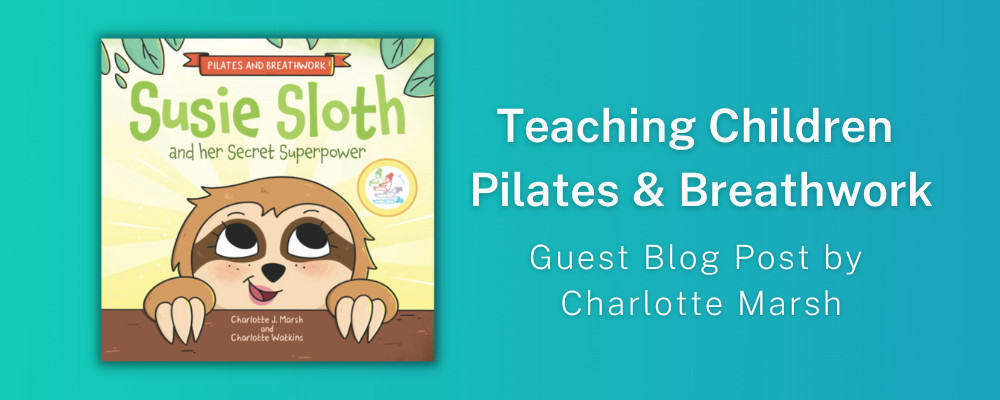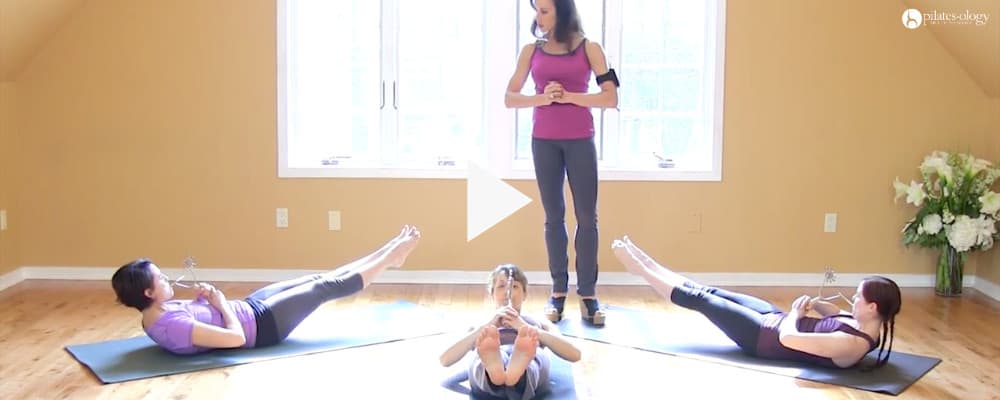Pilates & Breathwork For Children: Guest Blog from Charlotte Marsh

We’re so excited for this week’s guest blog post! Charlotte Marsh is the author of the newly released children’s book: Susie Sloth and her Secret Superpower: Pilates exercises and breathwork practices. Today, she’s sharing her story writing this book, how Pilates and breathwork are linked, and the importance of teaching this to children in a fun, gentle way. Thank you for sharing with us, Charlotte!
Pilates and Breathwork, how closely are they linked?
The good thing about speaking to Pilates proponents about breathing, is that you know you’re speaking to an already informed audience.
Whether you teach Pilates or you love to practice Pilates, you’ll know very well, the importance that is placed on the breathing with Pilates movements.
Joseph Pilates himself wrote “…it is tragically deplorable to contemplate the millions and millions who never learned to master the art of correct breathing.” Pilates’ Return to Life Through Contrology, 1998 Presentation Dynamics, First Published in 1946 by J.J.Augustine
Chuck Rapoport the photographer who shot the famous pictures of Joseph Pilates in 1961, said Joe was often seen with a cigar and the studio had a grimey appearance, that of a dark gymnasium studio. Hard to fathom by today’s standards isn’t it? Despite the emphasis on healthy breathing, did you know that Joseph Pilates sadly died from emphysema?
Whilst there’s even specific equipment within a Pilates Studio to specifically work with the breath, eg: the breathacizer, most Pilates sessions will refer to your breathing in one way or another.
Check out Kathi’s Breath-a-cizer How To Class below:

It might be during The Hundred, or if not at the start, by the time you are doing a Pilates push up, you’ve surely focussed on your breathing by then!
How can Pilates lead to better control over breathing?
Developing control over your breathing in Pilates will help you be more aware of the breathing habits in daily life.
As one develops more awareness around our inner core, how the diaphragm and pelvic floor work in unison as a perfectly combined duo, so we strengthen that connection.
So many people breathe in a shallow manner, not allowing full range of movement from the diaphragm. Equally, with constant stress and a rushing lifestyle, many people find themselves gripping through the pelvic floor almost constantly. Clenching until one can clench no more! A Pilates practice, if breath awareness is incorporated, can rebalance this perfectly designed coordinated system.
Another advantage is the so called “mind:body” connection that a Pilates experience can offer – less of a “connection” when we are surely one unified entity. For some people, their first Pilates experience can be the only time they have to concentrate with such precision and they find themselves searching within to feel their body. Sensing your body – known as interoception – is what we do when we practice breathwork, as we sense how fast/slow, how deep/shallow our breathing flows.
How does Breathwork transfer into more patient and positive parenting?
We often rely on our intuition when it comes to parenting, but in this modern world, it can be hard to tune in to your sixth sense when you’re feeling stressed from the daily grind and juggle.
From soothing a new born baby, or guiding your toddler to reset after a tantrum, to riding the waves of school anxiety, plus staying connected with your teen as they navigate their turmoil…we need to guide our children and not automatically match their reactions.
Breathwork tips make a world of difference as we strive for the calmest nervous system in the room.
Try using curious compassion & realise big feelings are really hard for kids to handle.
It’s truly NOT personal, even when they say “I hate you”, if you can see past the words, you can let that phrase just be carried on a breeze, let it waft right past you. It’s not about you.
Connect with how they are feeling and mirror with your own understanding of what they’re experiencing.
Really focus on your slow breathing & notice the pause between inhale and exhale. Use that tiny space to steady yourself and try to stay calm.
Trust me, this can work. If you practise slow breathing when you’re not stressed, you will find it easier to access when you are. A momentary pause is sometimes enough to make a better parenting choice.
What actually is a Breathwork?!
Good question! The answer will depend on who you pose that question to….Breathwork can take on many different forms. It can be a therapeutic practice to release emotions, such as conscious connected breathwork, or it can be movement based in order to improve the biomechanics of the parts of the body involved in breathing, or it can be based on biochemistry, as the way you breathe effects the chemicals in your blood and the pH balance in your body.
How did you get into this work?
I became a Pilates teacher to better understand my own back pain. On my journey of qualifying and learning more about bodies, I experienced many different pain relief modalities, from the more main stream physio and sports massage to what some may call alternative therapies such as Be Activated, NKT, Square1, PRI. The mainstream treatments never asked me about breathing, the alternative treatments all started with assessing my breathing. I soon came to value the diaphragm and its central role in connecting the whole body. I studied breathing from lots of different perspectives and starting teaching other Pilates teachers more about it to bust some myths that exist about the breath in Pilates.
So what kind of Breathwork do you teach?
Now, I teach the Buteyko method which is based on the science of biochemistry. We practice specific exercises to improve breathing once we’ve assessed where each individual is starting from. I’ll also combine this protocol with movement exercises to free up more space in a client’s body to improve breathing patterns.
Why Buteyko?
The Buteyko appealed to me because of its proven track record helping those with shortness of breath, feelings of anxiety & panic disorder, sleep apnea and other conditions.
What’s the main thing you wish people understood about Breathwork?
If everyone could be made aware that the majority of people overbreathe, that would be a good place to start. Also, for most of my life, I believed that carbon dioxide was just a waste gas and served no purpose to a human body – that’s completely incorrect. We need the right amount of CO2 in our system in order to send the oxygen where it’s needed.
So it’s not a matter of taking bigger or deeper breaths. We need to slow our breathing down, breathe less air in, build up a tolerance to CO2 and then we will actually be able to use more available oxygen.
How can I improve my breathing technique?
To improve breathing technique, get the basics right first; close your mouth and use your nose, work to clear your airways, practice low and slow breathing exercises, maintain good posture, engage in regular physical activity, quit smoking, and manage stress through relaxation techniques. Even better would be to get your breathing assessed and work on a specific set of exercises. Improve your focus, sleep, digestion, performance, relationships – everything is effected by better breathing!
Is it suitable for young children?
Yes! Why not? We’re all breathing already aren’t we, so why not teach them about their breathing system? How it connects their body to brain and vice-versa, to their emotions, explain how their physiology works. I wish someone had taught me about breathing earlier, more so than Pythagoras (sorry Dad!). Also with 1 in 5 kids in the US now suffering with a mental health condition and anxiety in children rising at alarm in rates, breathwork techniques can help.
Tell us about this exciting new Pilates & Breathwork book!
When I first qualified to teach Pilates to children, I was so disappointed to find out that there wasn’t a single storybook about Pilates for kids, despite there being thousands for yoga!
When lockdowns hit, I taught family sessions over Facebook live and made up a little story each week. Susie Sloth and her Secret Superpower was born!
🦥 Susie Sloth enters a magical tree tunnel and crawls out to find a whole new world awaits!
🦥She makes new friends with amazing animals who all have a special skill but can anyone guess her secret superpower?
🦥 A sweet and interactive tale introducing Pilates movements at every turn.
🦥 Her superpower ~ controlling her breath ~ is a secret no more and so we discover her top five breathwork exercises.
🦥 A captivating activity book that boosts well-being for little bodies and minds and provides a perfect connected play session.
Guest Blog Post written by Charlotte Marsh for Pilatesology
Tags:

From the Community